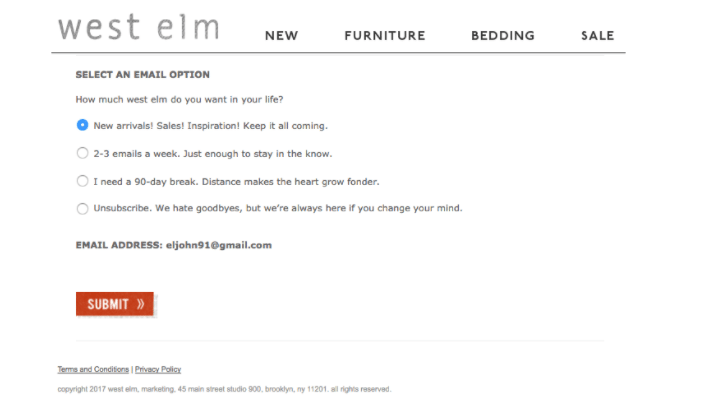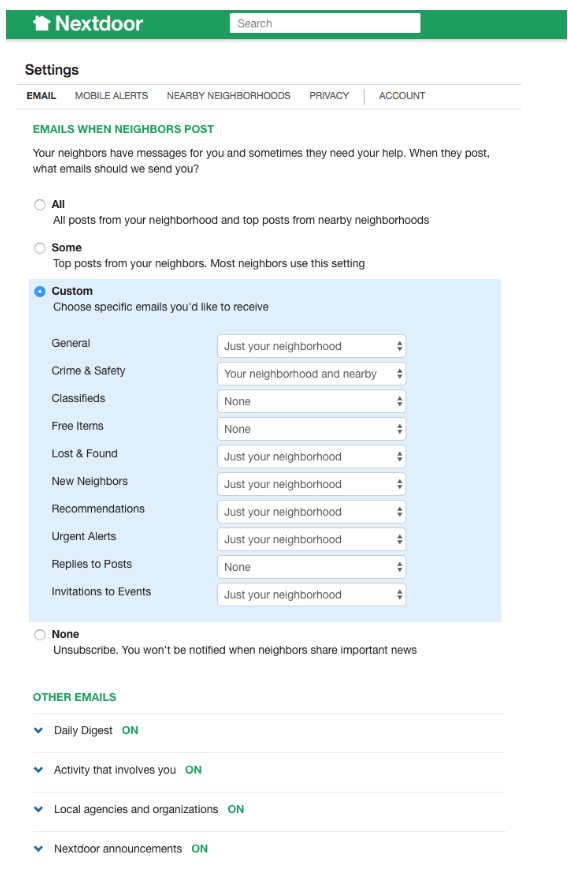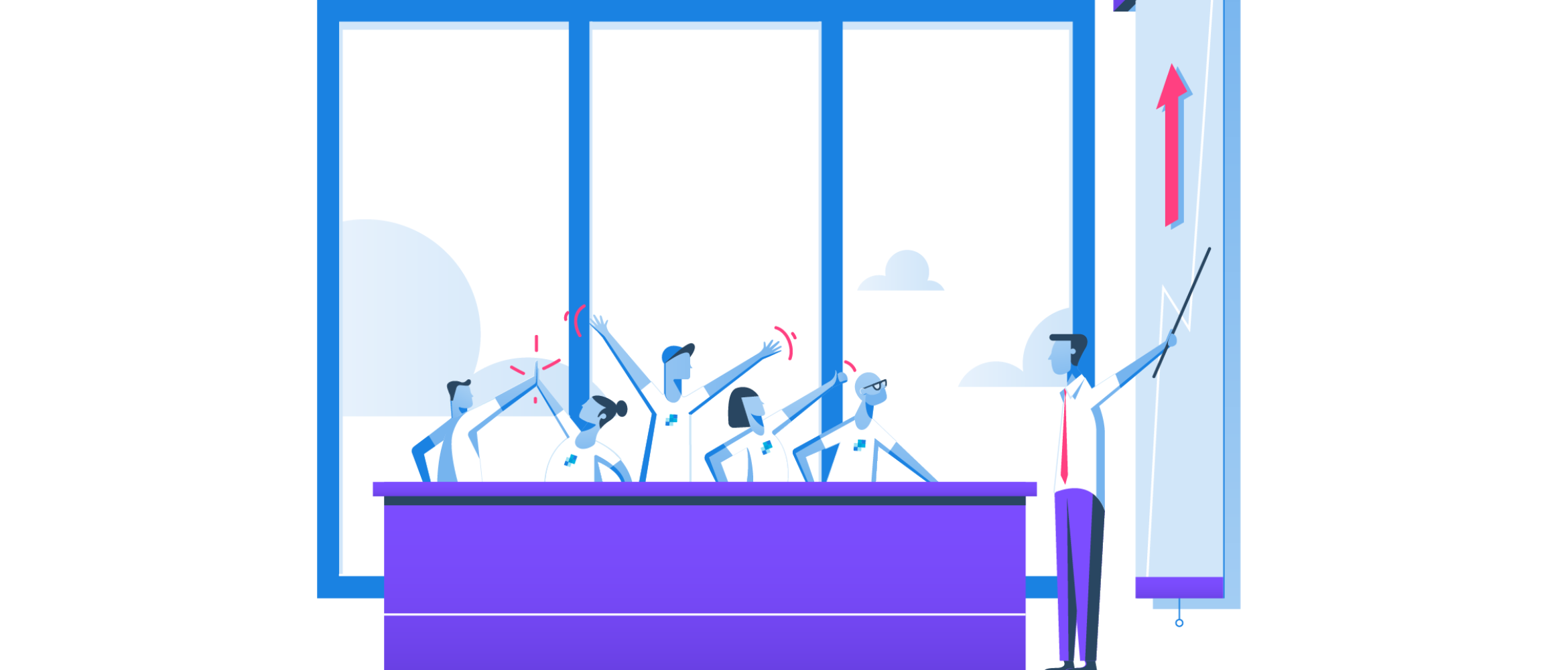It’s inevitable that some of your recipients might
fall out of love with your email or start to feel some email fatigue (with the average person receiving
up to 100 emails/day it’s no surprise!)! No matter how helpful your content is or how impressive and creative your templates are, unsubscribes are just a fact of life in the email marketing world—and that's where an email preference center comes in handy.
Even though it’s sad to say “goodbye,” every world-class email program has one thing in common: an easy-to-use unsubscribe feature. Having an unsubscribe feature is mandated by law in most countries, but recently we’ve seen even more marketers providing an even more powerful tool to manage emails with their recipients: preference centers.
An email preference center is powerful because it gives your subscribers an option other than removing themselves completely from your marketing list. Keeping marketable leads in the mix is a win for your business and, more importantly, it’s an overall better experience for your subscribers. There are three common kinds of preference centers broken down below.
An email preference center allows your subscribers to manage and customize their email communication preferences. They can take control of the type, frequency, and content of the emails they receive.
Without a preference center, customers have two options:
- Keep receiving all emails
- Unsubscribe from all emails
However, your customers might like
some of your emails but not others—that doesn't mean you should lose them entirely. An email preference center gives them a sweet middle ground. They get to pick and choose the emails they receive, creating the exact inbox experience they want.
Here are the key features and benefits of an email preference center:
- Customization: Subscribers can choose the topics or types of emails they want to receive. For instance, they might opt to receive product updates but not promotional offers.
- Frequency management: Subscribers can decide how often they want to hear from the business—daily, weekly, monthly, or only for major announcements.
- Profile updates: Subscribers can update their personal information, such as name, email address, and other relevant details.
- Opt-down: Instead of completely unsubscribing, users can "opt-down" by reducing the frequency of emails or choosing only specific types of emails.
- Feedback: Some preference centers allow subscribers to provide feedback on why they are changing their preferences or unsubscribing, giving businesses valuable insights.
- Compliance: With data protection regulations like the General Data Protection Regulation (GDPR) and the California Consumer Privacy Act (CCPA), businesses are required to provide users with more control over their data. An email preference center helps businesses comply with these regulations.
- Reduced unsubscribes: By giving subscribers the option to adjust their preferences rather than completely opting out, businesses can reduce the overall number of unsubscribes.
- Subscriber engagement: When subscribers receive content that's relevant and tailored to their preferences, they are more likely to engage with the emails, leading to higher open and click-through rates.
- Email deliverability: By sending emails that subscribers want to receive, businesses can improve their email deliverability rates and reduce the chances of their emails being marked as spam.
This type of preference center gives your subscribers the option to receive email less often, on a specific cadence, or a chance to take a set break from receiving email for a set amount of time. West Elm has a great time-based preference center.

You can see that they give their subscribers the option to opt-in to email, slow their email cadence, take a 90-day break from email altogether, and finally the option to unsubscribe.
Where time-based preference centers help your subscribers pick the cadence at which they receive your email, a content-based preference center lets them pick the types of communication that they do or do not want you to send them. NextDoor provides a content-based preference page that includes the option to receive all, some, or custom email updates.

NextDoor breaks communication down by the categories their users post in on their site and let subscribers choose all, some, or just the categories that are important to them.
Hybrid preference centers break out preferences by both time and content types.
You give subscribers an easy way to unsubscribe altogether, pause marketing emails for 90 days, and offer them the choice to “customize” the content in the emails they receive.
Implementing an email preference center is a great step towards enhancing user experience and ensuring compliance with data protection regulations. However, not all preference centers are created equally.
Here are a few tips and best practices to help you get the most out of your preference center:
- Easy access: Ensure that the link to the preference center is easily accessible, typically found in the footer of every email you send.
- Intuitive design: The design should be user-friendly, with clear navigation and straightforward options. Avoid jargon or overly technical terms.
- Clear descriptions: Each email type or category should have a clear description so subscribers understand what they're opting into or out of.
- Frequency options: Allow subscribers to choose how often they want to receive emails, such as daily, weekly, or monthly.
- Opt-down instead of opt-out: Before a subscriber completely unsubscribes, offer them the option to receive fewer emails or only specific types of emails.
- Confirmation: Once a subscriber updates their preferences, send a confirmation email or display a confirmation message to acknowledge the changes.
- Segmentation: Use the data from the preference center to segment your email list and send targeted content based on individual preferences.
- Feedback mechanism: Allow subscribers to provide feedback when they change preferences or unsubscribe. This can provide valuable insights into why they're making changes.
- Regularly promote the preference center: Occasionally remind subscribers about the preference center, especially if you introduce new content categories or other significant changes.
- Mobile responsiveness: Ensure that the preference center is mobile-friendly since many users access emails on their mobile devices.
- Quick unsubscribe option: While it's beneficial to offer various preferences, always include a quick and easy unsubscribe option for those who want to opt out entirely.
- Respect preferences: Once a subscriber changes their preferences, respect them immediately. Failing to do so will diminish trust in your preference center, and the recipient might mark your next message as spam.
Since SendGrid started using a preference center instead of a single option to unsubscribe, we have been monitoring things closely and the results are positive.
The preference center has caused a 20% drop in total unsubscribes from our email program.
This shows that while someone might need a breather from our email, or just might not want to learn more about new SendGrid products, they do value some marketing communication from us and would otherwise not be able to receive it with a simple unsubscribe page.
If you are a
SendGrid Marketing Campaigns customer and are looking for an easy way to get started with an email preference center, take a look at setting up various content groups with our
Unsubscribe Groups function. Unsubscribe groups are a great way to help your customers pick the content that they don’t want to receive.
Remember to let your recipients decide how much email they receive from you and you should see a rise in engagement!Read about 3 common types of email preference centers–a powerful tool in any email marketer's toolkit that helps increase engagement.



